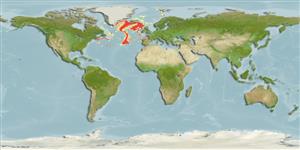Holocephali (chimaeras) >
Chimaeriformes (Chimaeras) >
Chimaeridae (Shortnose chimaeras or ratfishes)
Etymology: Hydrolagus: hydro-, combining form of hydor (Gr.), water; lagos (Gr.), hare, i.e., “water rabbit,” probably referring to three pairs of tooth plates, which tend to protrude from the mouth like a rabbit’s incisors (See ETYFish); pallidus: Latin for pale, referring to its pallid coloration (See ETYFish).
Environment: milieu / climate zone / depth range / distribution range
Ecology
Marine; bathydemersal; depth range 800 - 2700 m (Ref. 83979). Deep-water
Northeast Atlantic: Iceland.
Size / Weight / Age
Maturity: Lm ? range ? - ? cm
Max length : 62.0 cm TL male/unsexed; (Ref. 43774)
Oviparous (Ref. 205). Eggs are encased in horny shells (Ref. 205). Depth range along the mid-Atlantic ridge (Ref. 83979, C.Cotton pers.comm. 03/10).
Life cycle and mating behavior
Maturity | Reproduction | Spawning | Eggs | Fecundity | Larvae
Jonsson, G., 1992. Islenskir fiskar. Fiolvi, Reykjavik, 568 pp. (Ref. 12462)
IUCN Red List Status (Ref. 130435: Version 2024-2)
Threat to humans
Harmless
Human uses
Tools
Special reports
Download XML
Internet sources
Estimates based on models
Preferred temperature (Ref.
123201): 3.5 - 6.2, mean 4.2 °C (based on 256 cells).
Phylogenetic diversity index (Ref.
82804): PD
50 = 0.5000 [Uniqueness, from 0.5 = low to 2.0 = high].
Bayesian length-weight: a=0.00331 (0.00137 - 0.00798), b=3.07 (2.86 - 3.28), in cm total length, based on LWR estimates for this (Sub)family-body shape (Ref.
93245).
Trophic level (Ref.
69278): 3.8 ±0.6 se; based on size and trophs of closest relatives
Resilience (Ref.
120179): Low, minimum population doubling time 4.5 - 14 years (Assuming Fec <100).
Fishing Vulnerability (Ref.
59153): Moderate vulnerability (45 of 100).
Nutrients (Ref.
124155): Calcium = 89.7 [16.4, 537.6] mg/100g; Iron = 0.629 [0.172, 2.104] mg/100g; Protein = 14.3 [8.3, 17.7] %; Omega3 = 0.538 [0.147, 2.085] g/100g; Selenium = 5.22 [1.07, 30.11] μg/100g; VitaminA = 207 [22, 1,963] μg/100g; Zinc = 1.37 [0.59, 3.44] mg/100g (wet weight);
